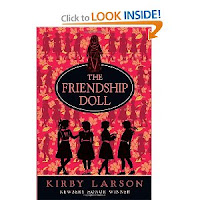
If only The Evolution of Calpurnia Tate by Jacqueline Kelly had been around back then! I loved, loved, loved this book! I loved the setting (Texas, 1899), I loved the story, I loved the writing, I loved the cover, and, most of all, I loved 11-year-old Calpurnia, a budding naturalist with an interest in evolution, who is constrained by the mores of her time. Luckily, she has a mentor in her grandfather but the book's ending left a question in my mind of whether Calpurnia would fulfill her intellectual potential or be forced by circumstance into a life she considered domestic slavery. This passage, about Calpurnia's discovery that there are other women scientists, and that she is not the only one of "her kind," like the last firefly of the season, was one of my favorites: "How sad to be the last of your kind, flashing your signal in the dark, alone, to nothingness. But I was not alone, was I? I had learned that there were others of my kind out there." I hope that those others see Calpurnia's flashing signal. I know that readers of this book will.
After visiting turn-of-the-last-century Texas, I traveled to New York, Chicago, rural Kentucky and across the country with an Okie child and her dad, all just before or during the Great Depression in Kirby Larson's The Friendship Doll. Following the travels of Miss Kanagawa, one of the fifty-eight Friendship Dolls sent to America by the Japanese in 1927, I criss-crossed the continent, meeting the children who awaken Miss Kanagawa's heart, and whose hearts she touches. For in the tradition of Rumer Godden's works about dolls (which I now feel compelled to reread), Miss Kanagawa is not a mere inanimate plaything. She "speaks" to children and they hear her, loud and clear and, just as they learn from her, she learns from them. However, just as I got into each story (the book is divided into separate chapters for each of the important children in Miss Kanagawa's "life"), it would end! In addition, some of the plot twists seem unnecessarily sad. (Then again, sappy endings can be annoying too - I guess I'm never satisfied!). Finally, the book jacket suggests that the reader may solve the mystery of the thirteen missing Friendship Dolls, but that mystery does not figure into the book at all. Perhaps the author was hoping a reader would turn out to be the owner of one of the missing dolls? I liked that Ms. Larson provided notes at the end, indicating which parts of the story were true to history and which she took liberties with, as well as noting where some of the Friendship Dolls can be seen.
As for adult historical fiction, I recently enjoyed The American Heiress by Daisy Goodwin.
What are your favorite historical novels, either for adults or kids? What kind of books take you back to your childhood reading habits?

The Great Brain series
ReplyDelete